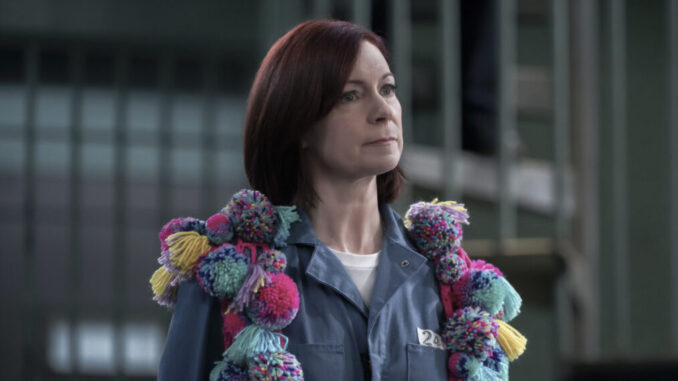
Behind the Scenes: The Calculated Chaos of Elsbeth Tascioni’s Eccentric Style
Elsbeth Tascioni doesn’t just enter a room; she explodes into it, a brightly plumed bird flitting through a staid legal drama. Her mind, a labyrinth of brilliant non-sequiturs, mirrors her appearance: a delightful, disarming chaos that belies a razor-sharp intellect. From her debut in The Good Wife to her triumphant return in Elsbeth, her eccentric style has become as iconic as her bewildering questions. But this isn’t merely a character trait; it’s a meticulously crafted facade, a collaborative masterpiece born from the brilliance of writers, the genius of an actor, and the keen eye of costume designers, all working in concert to forge an unforgettable television persona.
The genesis of Elsbeth’s unique charm lies deeply within the writing room of Robert and Michelle King. They conceived her not just as a quirky lawyer, but as a deliberate narrative device: a character whose outward disarray would serve as her greatest weapon. Her initial appearances in The Good Wife required an immediate, striking impression. The Kings needed a lawyer who could effortlessly disarm opponents, who could see patterns others missed precisely because her mind worked in seemingly tangential ways. Her dialogue, peppered with anecdotes about her children, observations about local flora, or sudden, seemingly irrelevant questions, was the first layer of eccentricity. This verbal tapestry was designed to make her underestimated, allowing her to glean crucial information while her adversaries dismissed her as merely peculiar. The “how” began with a strategic decision to weaponize distraction and create an intelligence that operates outside conventional lines.
However, a character on paper only truly comes alive through the actor. Carrie Preston’s embodiment of Elsbeth Tascioni is nothing short of alchemical. Preston doesn’t just deliver the lines; she becomes the calculated chaos. Her physical performance is a masterclass in controlled fidgeting, wide-eyed wonder, and an almost childlike earnestness that makes Elsbeth so endearing. The slight head tilts, the sudden gasps of realization, the way she pauses to absorb an environment before launching into an unrelated anecdote – these are Preston’s contributions to the “behind the scenes” creation of the style. She infuses Elsbeth with a palpable, almost vulnerable humanity that prevents the eccentricity from becoming a caricature. It’s Preston who finds the precise balance between the brilliant and the bizarre, allowing the audience to simultaneously root for and be endlessly amused by Elsbeth. Her acting elevates the written quirks into a living, breathing, brilliantly disarming persona.
The most visually striking aspect of Elsbeth’s style, and perhaps the most immediate “behind the scenes” creation, is her wardrobe. Costume designers have meticulously crafted a look that is both distinctive and reflective of her internal world. Forget sleek power suits or minimalist elegance; Elsbeth’s closet is a vibrant explosion of color, pattern, and texture. She often sports bright, jewel-toned jackets, sometimes paired with blouses featuring clashing patterns—a floral print under a geometric blazer, or a polka-dot dress adorned with a bold, almost sculptural brooch. Her accessories are carefully chosen statement pieces: oversized glasses that lend her a perpetually curious air, chunky necklaces, and an array of whimsical pins that might depict anything from a bumblebee to a miniature teapot.
This isn’t random, nor is it merely “bad taste.” It’s a deliberate visual strategy. The clashing patterns and unexpected combinations serve to draw the eye, creating a visual distraction that reinforces her verbal disarming techniques. It’s a designer wardrobe, yes, but one assembled with an individualistic, almost childlike joy, rather than a conscious effort to project status. Her hair is often styled in a slightly mussed, unfussy way, a few flyaways adding to her approachable, slightly disheveled charm. Every element, from the vibrant scarf to the slightly askew brooch, contributes to the illusion of harmlessness, making her opponents drop their guard just long enough for Elsbeth to spot the crucial detail no one else would notice. The costume team works with the narrative, ensuring that Elsbeth’s outfits are not just clothes, but a vital part of her strategic arsenal.
In essence, Elsbeth Tascioni’s eccentric style is a testament to the synergistic power of creative collaboration. It was born from writers who understood the potency of underestimated genius, sculpted by an actor who could embody both brilliance and bewildering charm, and visually amplified by costume designers who dressed her in a language of calculated chaos. “Behind the scenes,” her style wasn’t a fluke; it was a carefully constructed persona, a vibrant, disarming camouflage that transformed Elsbeth Tascioni into one of television’s most beloved and enduring legal luminaries, proving that sometimes, the most effective way to see everything is to make sure no one sees you coming.
